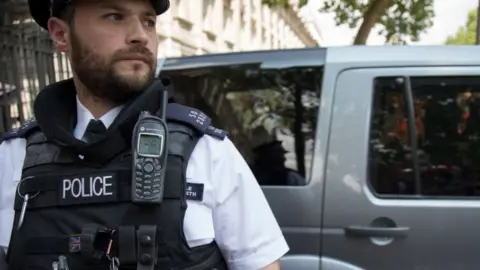Huawei's kit removed from emergency services 4G network
 Getty Images
Getty ImagesBT has confirmed that equipment made by Huawei is being removed from the heart of a communication system being developed for the UK's police forces and other emergency services.
It follows a statement from BT earlier this month that it was swapping out the Chinese firm's kit from the "core" of its 3G and 4G mobile networks.
The Sunday Telegraph was first to report the latest development.
It said the move could extend work on the late-running £2.3bn project.
BT is covering the cost of the switch. It does not believe the changeover will lead to a further delay.
Priority access
The Emergency Services Network (ESN) was originally due to be completed by the end of 2019.
At that point it was meant to replace an existing Motorola-owned radio system called Airwave, which is used by the police, fire and rescue, and ambulance services.
The ESN is intended to give its users "secure" priority access to EE's 4G network, which is being extended via additional radio frequencies in rural areas and new mast sites. It should be cheaper to run than Airwave while also providing superior voice and data capabilities.
But the effort is overrunning, and in September the Home Office announced that it would pay for use of Airwave until the end of 2022 with scope for a further extension if required.
EE won the contract to roll out the ESN in 2015, a year before the network provider was acquired by BT.
Since then, it has become subject to a BT policy that Huawei's kit should not be used at the core of its mobile networks to push customers' data about.
 Getty Images
Getty ImagesInstead, BT limits the equipment to periphery parts such as phone mast antennas.
"We have ongoing plans to swap to a new core network vendor for ESN, in line with BT's network architecture principles established in 2006," a spokesman for EE told the BBC.
"This will be managed with no disruption to the ESN service."
He added that it was still EE's intention to offer "full capability" of the system by 2020.
BT has not been explicit about the reasons behind its policy.
But security concerns have been raised about the use of Huawei's network infrastructure products, with the chief of MI6 Alex Younger recently saying Britain needed to decide how comfortable it was "with Chinese ownership of these technologies".
Even so, the Financial Times reported last week that telecoms executives are opposed to an outright ban, warning that such a move would set back deployment of 5G in the UK by up to a year.
Huawei has repeatedly rejected suggestions that it poses a risk and denies having ties to the Chinese government beyond those of being a law-abiding taxpayer.
